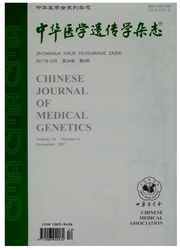

 中文摘要:
中文摘要:
目的对1例颜面部发育异常患儿进行细胞及分子遗传学分析,以明确其可能的遗传学病因,为家系的产前诊断提供依据。方法对患儿神经心理5项进行分析;应用彩色多普勒、CT及MRI对患儿全身结节进行探查;常规G显带分析患儿及父母外周血染色体核型;微阵列比较基因组杂交技术(arraycomparativegenomichybridization,aCGH)检测患儿及其父母全基因组染色体拷贝数变异(copynumbervariations,CNVs),并对CNV断裂部位进行精确定位。结果患儿智商及发育商偏低;MRI检查示患儿右侧颌面部皮下可见团片状混杂信号,CT及彩色多普勒检查见双侧背部多处不规则实性结节且富血供;患儿及其父母G显带核型分析结果均未见异常;aCGH检测显示患儿17号染色体长臂存在1.2Mb染色体缺失,分子核型为arr[hgl9]17q11.2(29124299—30326958)×1,父母均未见异常。结论患儿染色体17q11.2区段微缺失为新发生缺失,该区域染色体缺失可以导致颜面部异常、神经纤维瘤病等,该区段的缺失为患儿临床表型的病因。
 英文摘要:
英文摘要:
Objective To analyze a child with facial abnormalities with combined cytogenetic and molecular techniques and delineate its clinical phenotype. Methods Neuropsychological profile of the child was analyzed. Color Doppler, CT and MRI were used for detecting the nodules in the body. Conventional peripheral blood karyotypes of the child and his parents were analyzed with G-banding. Array-comparative genomic hybridization (aCGH) was performed to detect minor structural chromosomal abnormalities. Results The child had mental retardation, maxillofacial dysmorphism on the right side, and irregular solid nodules on the back. The karyotypes of the child and his parents were all normal, while aCGH has identified a de novo constitutive 1.2 Mb deletion at 17qll. 2 in the child. The aCGH results of his parents were normal. Conclusion The de novo 17q11.2 microdeletion probably underlies the facial abnormalities and neurofibromatosis in the patient.
 同期刊论文项目
同期刊论文项目
 同项目期刊论文
同项目期刊论文
 期刊信息
期刊信息
